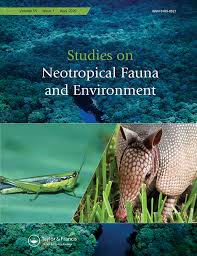Ver ítem
- xmlui.general.dspace_homeCentros Regionales y EEAsCentro Regional Buenos Aires NorteEEA Delta del ParanáArtículos científicosxmlui.ArtifactBrowser.ItemViewer.trail
- Inicio
- Centros Regionales y EEAs
- Centro Regional Buenos Aires Norte
- EEA Delta del Paraná
- Artículos científicos
- Ver ítem
Determinants of capybara presence in afforestations of the lower delta of the Paraná river, Argentina
Resumen
The delta of the Paraná River in Argentina represents the southernmost stronghold for capybaras (Hydrochoerus hydrochaeris), but this area is highly modified due to commercial afforestations with Salicaceae. Water management (e.g. drainage of marshes) and land protections (e.g. polders) are carried out to improve field conditions for developing afforestations. To assess determinants of capybara presence within polder afforestations, its presence was
[ver mas...]
The delta of the Paraná River in Argentina represents the southernmost stronghold for capybaras (Hydrochoerus hydrochaeris), but this area is highly modified due to commercial afforestations with Salicaceae. Water management (e.g. drainage of marshes) and land protections (e.g. polders) are carried out to improve field conditions for developing afforestations. To assess determinants of capybara presence within polder afforestations, its presence was surveyed in 2011–2013 along with 35 habitat and human-related variables at two spatial scales, in 53 watercourse-side sites. Using logistic regression, a habitat model was developed. Capybaras were present in 52.8% of sites. Water depth at the center of the watercourse had the strongest positive effect on capybara presence, followed by cover of reed marshes and cover of grass bush on the banks. Cover of adult poplar plantations showed a significant negative effect on capybara presence. Watercourses within polder afforestations can provide habitat for capybaras, although their use by these rodents depends on factors interacting at different scales.
[Cerrar]

Autor
Fracassi, Natalia;
Buchter, Wendy M.;
Pereira, Javier Adolfo;
Borodowski, Esteban Daniel;
Somma, Daniel Jorge;
Fuente
Studies on Neotropical Fauna and Environment 50 (3) : 229-237 (2015)
Fecha
2015
Editorial
Taylor & Francis
ISSN
0165-0521
1744-5140
1744-5140
Formato
pdf
Tipo de documento
artículo
Palabras Claves
Derechos de acceso
Restringido
 Excepto donde se diga explicitamente, este item se publica bajo la siguiente descripción: Creative Commons Attribution-NonCommercial-ShareAlike 2.5 Unported (CC BY-NC-SA 2.5)
Excepto donde se diga explicitamente, este item se publica bajo la siguiente descripción: Creative Commons Attribution-NonCommercial-ShareAlike 2.5 Unported (CC BY-NC-SA 2.5)

